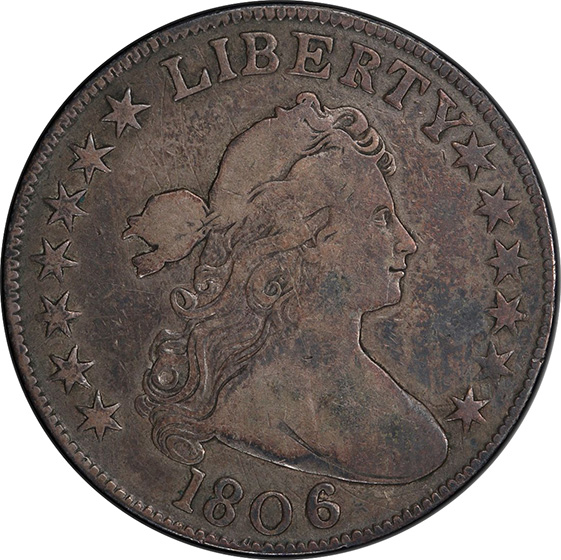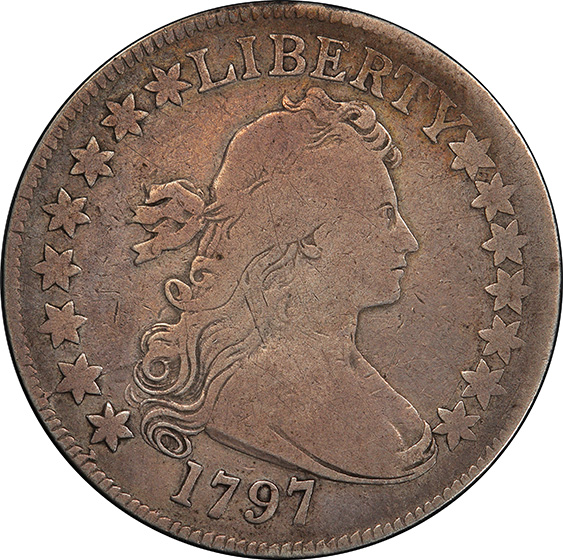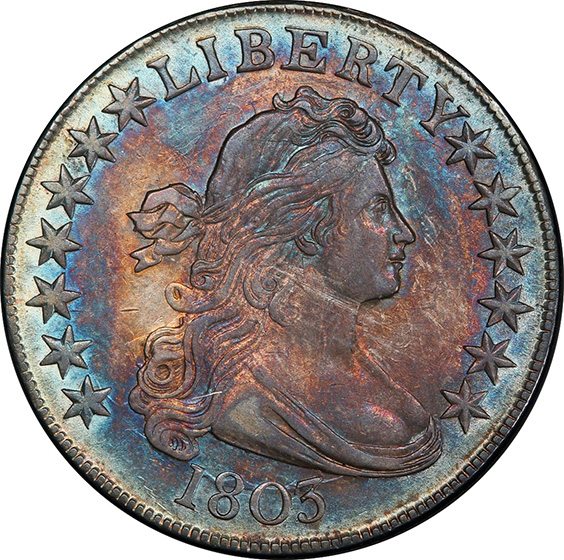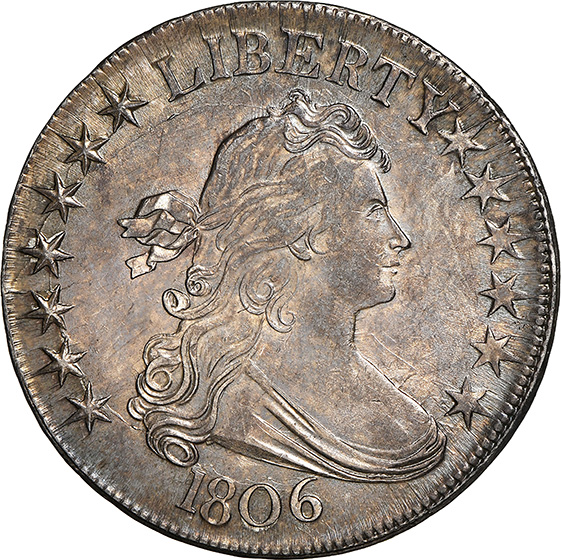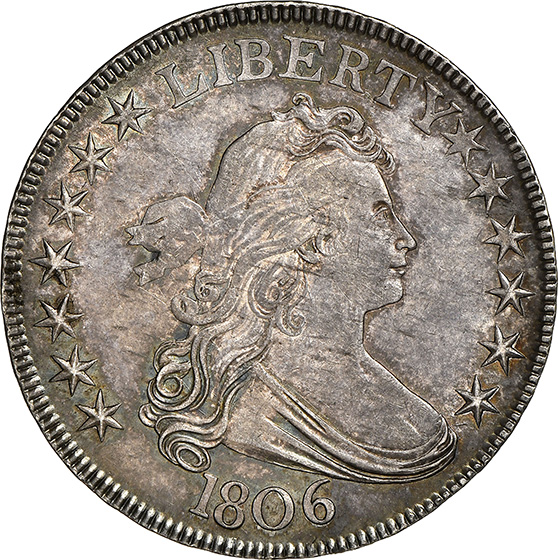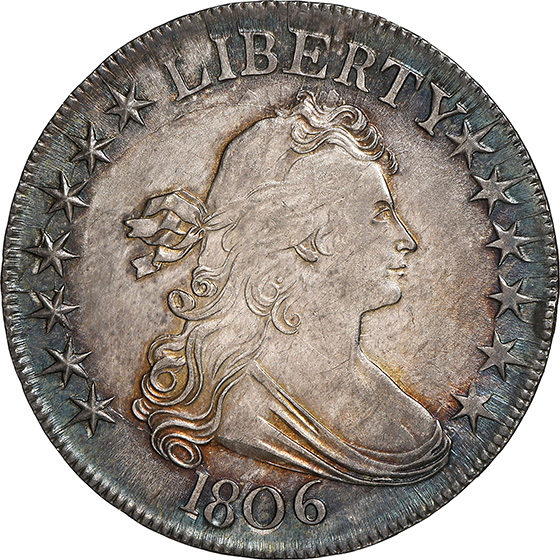Draped Bust, Small Eagle (1796-1797)
United States coin designs underwent rapid and sometimes radical change during the first few years of federal coinage. The fledgling U.S. Mint was keenly sensitive to criticism and seemed to be experimenting constantly in an effort to find just the right monetary image for the brand new nation.
The early silver coinage reflected this restlessness. Before the Mint was even ten years old, it had produced silver coins with three different designs. They weren’t entirely dissimilar; in fact, there was a great deal of overlap in their features as one type gave way to the next. Still, they have long been recognized by collectors as three distinct series, although admittedly short ones.
Not all the silver coins went through the entire progression; the dime and quarter were struck in only two types during that very first decade. The half dollar, however, was one silver coin that did touch all three bases. The importance of this denomination at the time made it inevitable that each successive design would immediately be translated to the half dollar.
The first half dollar was of the so-called Flowing Hair design. Its obverse featured a portrait of a youthful female figure whose hair flowed freely behind her; its reverse bore a small, spread-winged eagle surrounded by laurel branches.
After just two years of production, 1794 and 1795, the Mint replaced the youthful Miss Liberty with a more mature and more sedate portrait, one that has come to be known as the Draped Bust type. To a great extent, this resulted from a change in leadership at the Mint. The first director, David Rittenhouse, had resigned at the end of June, 1795, and his successor, Henry William DeSaussure, set out at once to improve the designs of all denominations, especially the silver pieces.
DeSaussure’s jaundiced view of existing coin designs may have been formed, in part, by comments he heard from some of their vocal critics. Consider, for example, the following putdown of the Flowing Hair and Small Eagle devices, which appeared in a letter from one Carlile Pollock to a certain General Williams of Salem, New York: “Nothing can be more wretched: an unmeaning fool’s head on one side, and something that resembles a turkey cock on the other. Oh, shame, shame, shame! The Eagle of America mantling the arms of the United States, as we see it on the City Hall, would have been a dignified impression, and on the other side, if the President’s head should be too aristocratic, a plough and a sheaf of wheat would be better than an Idiot’s head with flowing hair, which was meant to denote Liberty, but which the world will suppose was intended to designate the head of an Indian squaw.”
Pollock’s letter was dated January 25, 1796, well after the Flowing Hair portrait was replaced, so it couldn’t have figured in DeSaussure’s decision. In fact, DeSaussure himself was gone by then. He resigned on October 27, 1795, after less than five months on the job, due to illness and disaffection with the position. His successor was a former president of the Continental Congress, Elias Boudinot of New Jersey. By that time, however, the new design was already in place on the silver dollar, and arrangements had been made to use it on the other silver coinage. It made its debut on the half dollar in 1796.
While some might disagree with the critics of the Flowing Hair design (many collectors today, in fact, consider it quite appealing), there can be no quarrel with the choice of an artist to fashion its replacement. Reportedly at the urging of President George Washington himself, Director DeSaussure turned to famed artist Gilbert Stuart, who is today better remembered for his portrait of Washington employed on our current one-dollar note. Stuart is said to have used as his model a Philadelphia socialite widely considered to be the most beautiful woman of her day: Mrs. William Bingham (nee Ann Willing). Contemplating the Flowing Hair motif in 1795, Stuart is said to have remarked that Liberty had “run mad,” adding: “We will bind it up and thus render her a steady matron.”
Gilbert Stuart’s drawing was transferred to plaster by a Providence, Rhode Island artist named John Eckstein, and Mint Chief Engraver Robert Scot then executed the coinage dies. Stuart, disappointed with Scot’s interpretation, disavowed the work entirely, and it was not generations later that his connection to it was rediscovered.
Like her more youthful predecessor, this matronly Liberty had stars alongside her. Curiously, though, the number of stars increased from fifteen to sixteen partway through the 1796 production year, after Tennessee was admitted to the Union as the 16th state. It then dropped back to fifteen in 1797, evidence that dies were mostly prepared in advance and then dated only as they were needed for coining.
The reverse was similar to that of the Flowing Hair design, but slightly modified. The eagle became more graceful, less ungainly, and its perch was moved from a rock to a cloud. Additionally, the branches were reworked and refined, with a palm branch now on the right and an olive branch on the left. As on the previous coinage, the inscription LIBERTY and the date appear on the obverse, UNITED STATES OF AMERICA on the reverse. Lettering on the edge proclaims the statement of value: FIFTY CENTS OR HALF A DOLLAR. For emphasis, the fraction 1/2 was added below the wreath.
Draped Bust half dollars with the Small Eagle reverse were struck with only two dates—1796 and 1797—and in minuscule quantities, at that. The combined total for both years is just 3,918 pieces (the Mint didn’t break down the figures). The Mint was concentrating on silver dollars and smaller silver coins at the time. No half dollars at all were made from 1798 through 1800 and, when production resumed in 1801, the Draped Bust was mated with a new reverse featuring a heraldic eagle.
No proofs are known for this series, but prooflike specimen pieces exist. Even though the series lasted just two years, it is almost always collected by type rather than date, because so few were made. This half dollar is, in fact, one of the pivotal keys and crowning glories of any type set.
Draped Bust/Small eagle half dollars are extremely scarce in all grades and virtually nonexistent in high mint state grades. Points to check for wear are the hair above Liberty’s forehead and the crest of the eagle’s breast.
Draped Bust, Heraldic Eagle (1801-1807)
The start of the 19th Century also marked a new beginning for the United States half dollar. After a three-year hiatus, this large silver coin returned in 1801 with a new design: the Draped Bust/Heraldic Eagle type.
The United States Mint wasn’t yet ten years old at the time, but this was already the third different design to appear on the fifty-cent piece, the two earlier series having lasted just two years apiece. Clearly, federal officials were casting about for just the right combination of symbolism and artistry to showcase on the young nation’s coinage.
The first half dollar, introduced in 1794, had been of the so-called Flowing Hair design. Its obverse bore the portrait of a youthful female figure whose hair flowed freely behind her; its reverse depicted a small, spread-winged eagle surrounded by laurel branches. After just two years of production, the Mint replaced the youthful likeness of Liberty with a more mature, almost matronly portrait, one commonly known as the Draped Bust type. Initially, however, it retained the small eagle, with subtle modifications, on the reverse. This design appeared on half dollars for only two dates: 1796 and 1797.
When the series resumed after the turn of the century, the naturalistic bird had given way to a larger, more formal eagle with a shield superimposed upon its breast: the now-familiar heraldic eagle design. This new series, too, was destined to be short-lived, lasting just six years. But, during that time, the Mint’s total output greatly exceeded the levels of previous years and, for the first time, the half dollar came to enjoy widespread use.
The Draped Bust portrait of Liberty may have resulted from the intercession of President George Washington himself. Its designer, painter Gilbert Stuart, is best known today for his portrait of Washington still used on the one-dollar note. Numismatic researcher R.W. Julian speculated that the president, being keenly interested in upgrading United States coinage, may have arranged for Stuart (whose work he much admired) to prepare this design.
It’s said that Stuart’s model was Mrs. William Bingham (nee Ann Willing), a Philadelphia socialite viewed by many contemporaries as the most beautiful woman of her day. Stuart’s drawing was transferred to plaster by sculptor John Eckstein of Providence, Rhode Island. Robert Scot, the Mint’s chief engraver, executed the coinage dies.
In his highly acclaimed book Numismatic Art in America, Cornelius Vermeule characterized the Draped Bust version of Liberty as “a buxom Roman matron” and observed that “her full face has been endowed with a Roman dignity that recalls some massive marble bust of Minerva or Dea Roma, goddess of Rome and her empire ...” Gilbert Stuart, however, was not satisfied with Scot’s interpretation of his work, and he disavowed all responsibility for it. Only years later was his association with this coinage rediscovered.
On half dollars of the Draped Bust type, the word LIBERTY appears above the portrait and the date below. 13 stars surround Miss Liberty on all coins of this series having the Heraldic Eagle reverse. This represents a refinement of the earlier Draped Bust coinage, on which the number of stars varied from 15 to 16, depending on the number of states in the Union at the time. Rather than subject this element of the design to continual change, Mint officials settled on a number reflecting the thirteen original colonies.
Thirteen stars also appear on the coin’s reverse, arrayed above the eagle. Chief Engraver Scot modeled the heraldic eagle after the one on the nation’s Great Seal. Unaccountably, however, he reversed the positions of the arrows and olive branch held in the eagle’s claws, placing the warlike arrows in the symbolically more important dexter (or right) claw and the olive branch of peace in the sinister (or left) claw, thereby contravening the Founding Fathers. A ribbon bearing the motto E PLURIBUS UNUM hangs from the beak, with UNITED STATES OF AMERICA around the upper rim. On the edge of each coins is the statement of value: FIFTY CENTS OR HALF A DOLLAR.
Draped Bust/Small Eagle half dollars had been struck in minuscule quantities, with a total two-year mintage of fewer than 4,000 pieces. By contrast, more than 1.6 million Draped Bust/Heraldic Eagle half dollars were minted over the years, with 1806 alone accounting for more than half that total: 839,576.
The 1806 halves come in seven major varieties, including two overdates (6-over-5 and 6-over-inverted-6), three with a knobbed 6 in the date and two with a pointed 6. By far the rarest is the knobbed-6 variety on which the stem of the olive branch doesn’t extend through the eagle’s claw. There also are two 1803 varieties: with a small and large 3. The Mint made no half dollars dated 1804, but evidently dies had been prepared for that year, for some 1805 pieces are 5-over-4 overdates.
Despite their relatively high mintages, few Draped Bust/Heraldic Eagle half dollars were preserved in pristine mint condition. There just weren’t many collectors around in those early days. In any event, fifty cents was a lot of money to set aside, representing a day’s pay for many working class Americans. Large numbers of these coins survive in the higher circulated grades, because banks routinely held them for use in inter-institutional transactions.
Grading this type can be challenging. Weak strikes were common, reducing the number of choice examples. Points to check for wear are the hair above Liberty’s forehead and the eagle’s breast feathers. Proofs were not struck for this series.
Draped Bust and Capped Bust half dollars both are widely collected by Overton die varieties. These are listed in the standard reference book Early Half Dollar Die Varieties 1794-1836 by Al C. Overton.
In 1807, Draped Bust halves gave way to a new version designed by Scot’s assistant, John Reich. This was the Capped Bust type, on which Miss Liberty turned from facing right to facing left and tucked her newly curled hair inside a cap.
Coin Descriptions Provided by Numismatic Guaranty Corporation (NGC)
(Less text)

